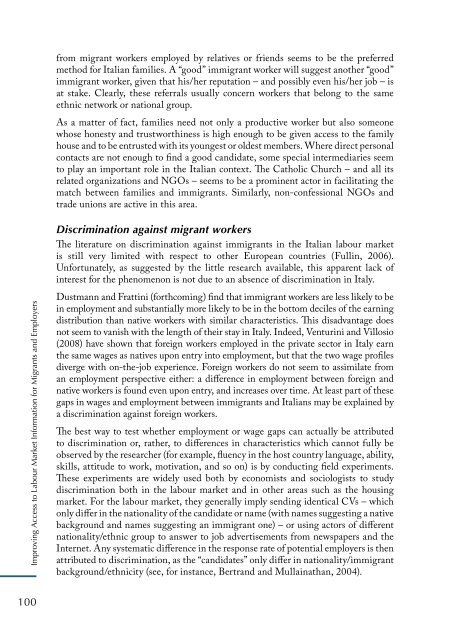International Organization for Migration (IOM)
International Organization for Migration (IOM)
International Organization for Migration (IOM)
Create successful ePaper yourself
Turn your PDF publications into a flip-book with our unique Google optimized e-Paper software.
Improving Access to Labour market In<strong>for</strong>mation <strong>for</strong> migrants and employers<br />
100<br />
from migrant workers employed by relatives or friends seems to be the preferred<br />
method <strong>for</strong> Italian families. A “good” immigrant worker will suggest another “good”<br />
immigrant worker, given that his/her reputation – and possibly even his/her job – is<br />
at stake. Clearly, these referrals usually concern workers that belong to the same<br />
ethnic network or national group.<br />
As a matter of fact, families need not only a productive worker but also someone<br />
whose honesty and trustworthiness is high enough to be given access to the family<br />
house and to be entrusted with its youngest or oldest members. Where direct personal<br />
contacts are not enough to find a good candidate, some special intermediaries seem<br />
to play an important role in the Italian context. The Catholic Church – and all its<br />
related organizations and NGOs – seems to be a prominent actor in facilitating the<br />
match between families and immigrants. Similarly, non-confessional NGOs and<br />
trade unions are active in this area.<br />
Discrimination against migrant workers<br />
The literature on discrimination against immigrants in the Italian labour market<br />
is still very limited with respect to other European countries (Fullin, 2006).<br />
Un<strong>for</strong>tunately, as suggested by the little research available, this apparent lack of<br />
interest <strong>for</strong> the phenomenon is not due to an absence of discrimination in Italy.<br />
Dustmann and Frattini (<strong>for</strong>thcoming) find that immigrant workers are less likely to be<br />
in employment and substantially more likely to be in the bottom deciles of the earning<br />
distribution than native workers with similar characteristics. This disadvantage does<br />
not seem to vanish with the length of their stay in Italy. Indeed, Venturini and Villosio<br />
(2008) have shown that <strong>for</strong>eign workers employed in the private sector in Italy earn<br />
the same wages as natives upon entry into employment, but that the two wage profiles<br />
diverge with on-the-job experience. Foreign workers do not seem to assimilate from<br />
an employment perspective either: a difference in employment between <strong>for</strong>eign and<br />
native workers is found even upon entry, and increases over time. At least part of these<br />
gaps in wages and employment between immigrants and Italians may be explained by<br />
a discrimination against <strong>for</strong>eign workers.<br />
The best way to test whether employment or wage gaps can actually be attributed<br />
to discrimination or, rather, to differences in characteristics which cannot fully be<br />
observed by the researcher (<strong>for</strong> example, fluency in the host country language, ability,<br />
skills, attitude to work, motivation, and so on) is by conducting field experiments.<br />
These experiments are widely used both by economists and sociologists to study<br />
discrimination both in the labour market and in other areas such as the housing<br />
market. For the labour market, they generally imply sending identical CVs – which<br />
only differ in the nationality of the candidate or name (with names suggesting a native<br />
background and names suggesting an immigrant one) – or using actors of different<br />
nationality/ethnic group to answer to job advertisements from newspapers and the<br />
Internet. Any systematic difference in the response rate of potential employers is then<br />
attributed to discrimination, as the “candidates” only differ in nationality/immigrant<br />
background/ethnicity (see, <strong>for</strong> instance, Bertrand and Mullainathan, 2004).


